Synthesis, Version 9.1 by FREDERIK SCHROYENS [#SCH9]
$200.00
Description
The 9.1 Edition is the newest version of this repertory. This version was first published in 2004.
** Integrating the major Repertory work of Bœnninghausen and Boger (448,000 additional author references)
** Full integration of separate repertories such as Boericke and Phatak
** Vastly increased new information (115 new remedies, including many recent provings and 473 remedies with more than 50% new information)
** Standardized and simplified repertory structure
You can read the new foreword by the editor this book (Frederik Schroyens, MD), plus additional comments from Jeremy Sherr by clicking here!
This major contribution to the literature is a new repertory with 200,000 additions, references to each medicine, and cross-references to other symptoms. Vithoulkas & Geukens supported.
If you like this repertory, you will LOVE the homeopathic software program that is based on it called RADAR! See our online catalog section on SOFTWARE, and see the various RADAR programs that we sell!
Book Review
Reprinted from The Homoeopath with permission from The Society of Homoeopaths, 2 Artizan Road, Northampton NN1 4HU, United Kingdom.
Reviewed by Nick Hewes
Despite the revolutionary possibilities of computer programmes such as Reference Works, which can scan roughly 200 years of materia medicas and homeopathic journals in a few seconds in order to find an exact word match, most homeopaths still love their dear old Repertory. The reverence in which we hold the latter is sometimes unconsciously transmitted to our patients, who often ask fondly, “is that your Bible?” My first Repertory, Pierre Schmidt’s version of Kent’s Final General Repertory, really did look like a sacred text, dog-eared, gold embossed and Bible-black as it was. It all added to the impression that the Repertory really did somehow contain the Truth.
On buying my first version of Synthesis in 1994, the price did hurt, but within days I had realised that this was one of those rare products which justifies the ad-man’s slogan: – “reassuringly expensive”; it is so opulent, so fastidiously produced, that simply turning its pages really does make one feel good; it’s a bit like spending money you really can’t afford on a nice pair of boots: – you may have had a terrible week, the phone hasn’t rung, your patients have missed their appointments, things fall apart and the centre cannot hold, but don’t worry, as soon as you put those expensive boots on, a voice says,”because… you’re worth it!”, and you start to feel better. So it is when you lash out on your next edition of Synthesis.
The eighth edition has some new features that improve on the last version. One advance on previous editions is the abstraction of all information extraneous to the Repertory itself into a completely separate volume. This is, in effect, a companion guide, (although it goes under the cumbersome title of Blueprint for a New Repertory); it carries remedy and author abbreviations, an index of key words, and a lengthy explanation of the editing process behind Synthesis 8. The creation of this separate volume is a very neat solution to the fact that the increasing size of the Repertory is starting to cause problems of unwieldiness.
This brings us to the most notable feature of Synthesis 8, which is the number of new additions, the quantity of which is truly staggering: – as Dr Schroyens himself tells us, “the amount of new information, compared to Synthesis 7, is almost equal to the information contained in the original Kent’s Repertory!” Much of this vast influx of information is from new provings, and as such is essential material for those homeopaths who want to benefit from the creative transformation of our discipline over these last 1 5 years. The provings have come from reliable sources like Louis Klein, Nuala Eising and the assorted drones and clones of Jeremy Sherr’s Dynamis School.
A second source of new information comes from a retrawling of materia medicas by classical authors like Hahnemann, Hering and TF Allen, many of whose symptoms were, surprisingly, left out of Kent’s original Repertory. Again, the inclusion of this information can only be to our collective benefit.
Thirdly, there are a great many additions, which come from the clinical experience of working homeopaths. Synthesis 8 has added information from a staggering 655 sources (compare that to sixteen sources of new additions in Klunker and Barthel’s first Synthetic Repertory). Now a great many of these sources will be completely unknown to most of us, so we have no option but to put our trust in the judgment of Dr Schroyens’ editorial team. In his defence, the great thing about Synthesis is that one can trace the source of any addition; this has always given it the edge over, for example, Murphy’s Repertory, which, although more imaginative and intuitive in structure, has always suffered from the fact that its additions are unattributed.
The fact is, sources matter. As Rajan Sankaran says in The Spirit of Homeopathy, “The inclusions and gradations of Pierre Schmidt, you can bet your life on”, but “Use great caution in the use of rubrics from Gallavardin”. Essentially Sankaran is pointing out that, as soon as you use additions to the Repertory, you have to start to use your discretion in how to grade the new information. For example, any addition from Vithoulkas (of which there are over 1600 in this update) is gold-plated; having worked in a holistic way with about 150,000 patients, if Vithoulkas tells you that Phosphorus has a craving for cheese, one simply nods politely in agreement. But what if I tell you that I’ve had a few nice cures, using Bryonia in patients who have been ill since moving house? Does that mean we need to create a new rubric: “Ailments; moving, from house”, and then to add Bryonia to it, with my initial after it? I’d have to say “Hang on a minute, I’m just a little man!” Meaning, adding new words to a Bible is a big responsibility.
The real problems, however, come with the fourth type of addition, which is comprised of theoretical, unconfirmed information. This really is a watershed in the evolution of Synthesis. Schroyens defends these inclusions, attributing them to the demands “of homeopaths requesting to have as much new information available as soon as possible”. It represents a sea change from the caution expressed in the introduction to Synthesis 7, where he wrote that if remedies are added “too quickly the expanded rubrics bring out differences in too many cases that ultimately lead to confusion. Hastily introduced information might be incorrect or irrelevant.”
In Synthesis 8, however, the Editor appears to have literally thrown his former caution to the winds, by bowing to popular pressure to include hypothetical information; “it almost appeared that we had to create two Repertories” he writes, “one with carefully checked and entered information, and one with quickly entered, often hypothetical information”. His solution to this conflict of interests was to mix all the material together, and to denote the hypothetical additions by enclosing them within square brackets. These brackets seem to say: “Don’t take my word for it guv, I’m just the Editor”. Schroyens justifies his inclusion of hypothetical remedies on the basis that, “it is the individual practitioner who decides which information to use or not”. But is he not simply shunting responsibility for choosing new additions onto the working homeopath, rather than the editorial team, which is where that responsibility really belongs? The idea of adding unconfirmed remedies to this formerly great Repertory, and then leaving it up to the reader to decide whether to use them or not, represents a democratisation of homeopathic knowledge, and may lead to a watering-down in our ideas of what a Repertory should be. Any quaint ideas of the Repertory as Bible are lost. if you mix up the Apocrypha with the Bible, what you are left with is no longer a Bible.
In defence of these editorial changes, it should be mentioned that, in almost every case, the bracketed remedies come from the pen of Jan Scholten, whose ingenious ideas on the periodic table have propelled homeopathy into a wholly new orbit. It would have been much better, however, to have created a completely separate Repertory for Scholten’s additions, rather than to have stigmatized them by enclosing the remedies within square brackets. Nhoj Eel, in one of his excellent columns in this journal, once advertised the publication of his new Repertory, which now had so many additions that every rubric contained every remedy in the materia medica. The serious message underlying Nhoj’s wit was that the babbling clamour for ,’more additions, more corrections and more streamlining” (to quote the first sentence of Schroyens’ foreword) would always tend toward the creation of bigger and bigger Repertories. Ultimately however, a larger Repertory may make the practice of homeopathy more confusing, because it becomes more difficult to differentiate. When we got stuck on cases at college, we used to joke that maybe the patient needed Repertory 1 Om! – What we were really admitting was that we had lost our ability to differentiate the characteristic points of the case. This state was often accompanied by a feeling that we were drowning in a sea of information. In homeopathy, more is not always better. To give an example of the potentially confusing effects of ‘rubric overgrowth’, take my last patient, who walked out of my door 15 minutes ago: because his life has been dominated by self-imposed financial constraints, I was confident that the rubric ‘Avaricious’ had to contain his remedy. His main complaint is a malignant tumour, and there were three remedies in my mind: – Calcarea fluorica, Conium and Carbo animalis. Reaching excitedly for my Synthesis 8, 1 turned to the rubric ‘Avarice’, fully expecting to thereby eliminate one, if not two of the original trio of remedies. Imagine my surprise to find that all three remedies are now in that rubric, two of them being additions. Even if these additions are justified, the end result is that I am now thoroughly confused, and will have to go away and think again about how to differentiate the remedy that is needed!
Synthesis has, over the last decade, brought a huge benefit to the lives of working homeopaths. I’m on my third edition, and I use this Repertory every working day of my life. I’ve always felt pride and gratitude that our profession has been able to benefit from this wonderfully rigorous, reliable text. The Synthesis series has justifiably acquired a reputation for scrupulous editorial caution. But Schroyens himself quotes the Latin dictum, “Verba volant, scripta manent” (“Words fly, writings remain”), meaning that once something is written down, it acquires a life of its own, and that therefore, one should proceed with great caution when enlarging a text like the Repertory. If this caution is relaxed, it may be to the long term detriment of the Dr Schroyens’ project, especially if it becomes an example of the Taoist saying: “Most great enterprises are ruined at the end”.
It’s important to remember that the word “babble” is derived from the name of the mythical city of Babel, which was ruined because people’s desire for unrestrained growth led to a state of total confusion. To return to the idea of ‘Repertory as Bible’, my preference would definitely be for the Repertory to aspire to the singular voice of truth, rather than to exchange its authority for the many voices of Babel. The words “Bible” and “Babel” may sound almost identical, but in terms of their meaning, each one is at opposite ends of a spectrum.
Book Review
[From The Homoeopath, Summer 1998, No. 70]
This book review is reprinted from The Homoeopath with permission from Nick Churchill of The Society of Homoeopaths.
Synthesis: Repertorium Homeopathicum Syntheticum, 7th edition, ed.
Frederik Schroyens, MD
New Delhi, India, 1997
Hardback, 1,781pp
Reviewed by Rachel Roberts
Investing in a new repertory is a major decision, not just because of the vital role the repertory plays in homoeopathic practice, but because of the considerable expense involved. Overall this edition of Synthesis is sufficiently comprehensive, accurate and practical to be an excellent choice for anyone from a first-year student to the most experienced practitioner.
There are several repertories available which are adapted and expanded versions of Kent’s Repertory, but Synthesis is the best example of this group. While most have tended to reproduce Kent in its entirety – warts and all – before making some corrections and the additions necessary to bring the 1916 text up to date, the writers of Synthesis appear to have done the most thorough job of painstakingly correcting errors in Kent’s work before its integration with the new material. Kent’s hierarchical structure has been retained; whether you prefer this traditional structure or an alphabetical layout is a matter of personal preference. However most students are first introduced to the wonders of repertorisation using Kent’s Repertory, as this classic text is the standard teaching repertory in most colleges. Synthesis therefore has the advantage of allowing those who were trained with Kent to move on to a more modern and complete repertory without having to get to know a new format from scratch.
A vast number of corrections and adaptations have been made to Kent’s text during the writing of Synthesis, some of which are discussed below. These improvements allow Kent’s valuable work to stay in use while eliminating the frustration caused by the textual errors, illogical symptom locations and ambiguous wording found in the original.
Homoeopaths may pride themselves on the ability to read and instantly understand sentences which have been chopped into several illogical sections, and arranged (approximately) backwards, but personally I was relieved to find that the writers of Synthesis have done what they can to make symptoms easier to read. As a rule sentences are either split only once, or words are put in their normal order as much as possible; the use of a semicolon to indicate where one should start reading the symptom from is another very simple but effective improvement. The headache of having to remember such idiosyncrasies as the food desires and aversions being in the ‘Stomach’ chapter, whilst food aggravations are listed in ‘Generalities’, has also been much reduced by moving certain symptoms to more logical locations. Ambiguous words have been replaced by more specific terms e.g. ‘breast’ is replaced by ‘chest’ or ‘mammae’ as appropriate, and where Kent’s meaning was insufficiently clear, symptoms have been reworded directly from the materia medica.
Synthesis has been written in contemporary English which makes symptoms more immediately relevant to modern practice and the repertory quicker to use. More importantly this also eliminates the inaccuracies of repertorisation which can arise from mistranslation of Kentian terminology.
When reviewing a technical text such as a repertory, one cannot assess its merits purely in isolation – a comparison must be made with other similar books on the market. Murphy’s Homeopathic Medical Repertory is probably the closest rival to Synthesis, being a modern, comprehensive, single-volume repertory. However, this is pretty much where any similarity ends.
This latest version of Synthesis has about 235,000 additions from highly respected homeopathic texts, giving priority to the classical authors – Kent, Hahnemann, Hering, Allen, Clarke, Boericke, Knerr etc. The editor gives an assurance that all additions are ‘repeatedly checked’ and that those from living authors are added ‘only with caution’ and usually in low type to maintain accuracy. The second edition of Murphy’s Repertory contains 200,000 additions from 56 authors, plus symptoms which have been clinically verified by three or more homeopaths. A list of authors is given in both repertories, but whilst in Synthesis all changes have been annotated to allow verification, Murphy’s Repertory has no annotations whatsoever within the text. There is therefore no way of distinguishing the original Kent (or Knerr) entries from changes or additions, let alone identifying the sources of the new material. Consequently readers have no way of assessing the reliability of the rubrics, making it difficult to have confidence in the repertory as a whole. Without such annotations one has to trust the writing and editorial team implicitly to have put the book together with the highest level of accuracy. However, I would have to say that such trust is not encouraged by the nine typing errors I came across in the six pages of preface and introduction in Murphy’s Repertory.
In Synthesis Kentian clinical rubrics have been renamed according to modern disease names e.g. ‘coryza – annual’ has become ‘hayfever’, but only a small number of totally new clinical rubrics have been introduced. In his Forward the editor comments that a cautionary approach was taken because ‘sufficient clinical verification is still lacking in most cases.’ By contrast, Murphy’s Repertory contains many new clinical rubrics such as Parkinson’s, MS and endometriosis. Whilst this is one of the main reasons for the considerable popularity of this repertory, I feel that it is another example of how Murphy seems to have gone for modernisation and expansion, without sufficient attention to verification; this is in direct contrast with the meticulous attention to detail of the Synthesis team.
At the back of this Indian edition of Synthesis there is a section called ‘Blueprint for a New Repertory’ in which the editor gives an explanation of the rules followed for the layout, plus exact details of all changes and corrections made. As I have just suggested, providing such detailed information is exactly how Synthesis inspires confidence in its readers, but as this section runs to 137 pages I think it would be more appropriate to publish the information as a separate supplement packaged with the repertory; this would reduce the bulkiness of this edition which weighs in at just over 4lbs.
The size, weight and quality of repertories is extremely important if they are intended to be portable, as they need to withstand frequent, long-term use plus being continually hauled from place to place. Murphy’s Repertory has the edge here, being a very compact, beautifully bound American edition printed on high quality bible paper. This Indian edition of Synthesis is considerably larger and printed on poorer paper, but this is reflected in the price; Synthesis retails from £59 while Murphy will set you back £70. A slightly revised Synthesis 7.7 is due to be printed this summer, with a European edition being available from July 1998 at £95 and an Indian edition coming out in September. if the price of the English Synthesis is not prohibitive, this should be an ideal repertory (especially for those who already have Kent’s structure ingrained in their brains) with the excellence of the text being matched by the improved presentation.

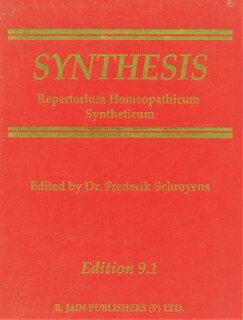
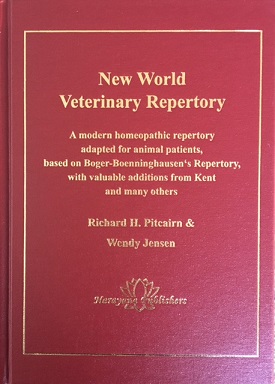

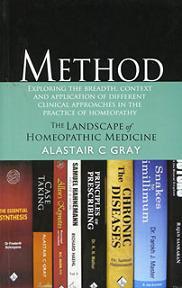
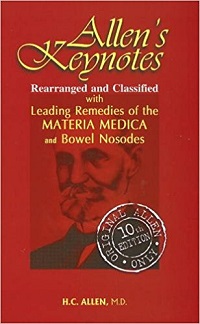
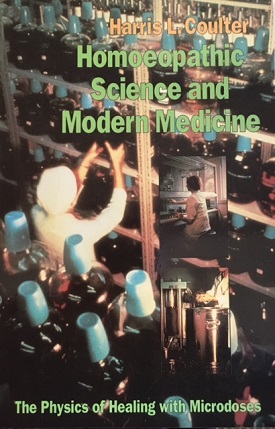
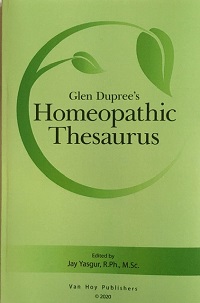
Reviews
There are no reviews yet.